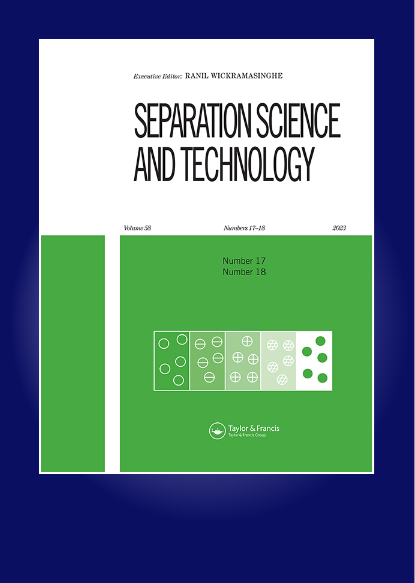芴-二苯并呋喃体系的汽液平衡和共沸蒸馏模拟研究
IF 2.3
4区 工程技术
Q3 CHEMISTRY, MULTIDISCIPLINARY
引用次数: 0
摘要
摘要 本研究主要通过二元相平衡实验和共沸蒸馏模拟来分离芴-二苯并呋喃体系。采用增强型 Othmer 平衡蒸馏器进行相平衡实验,并将获得的数据进行关联,以确定缺失的二元相互作用参数。所得实验数据证明了热力学的一致性和可靠性。随后使用 NRTL、UNIQUAC 和 Wilson 模型进行相关性分析,结果表明 UNIQUAC 模型与实验值非常吻合。这凸显了该模型精确描述芴-二苯并呋喃体系相行为的能力。相平衡研究提供了关键的参数和预测,为后续的分离过程模拟和设备开发奠定了基础。共沸模拟采用乙二醇作为共沸溶剂,并通过 Aspen 软件进行模拟,得到了纯度最低≥ 98% 的高纯度芴产品。这些发现强调了共沸蒸馏在芴-二苯并呋喃体系中实现高纯度分离的功效,对工业应用具有广阔的前景。本文章由计算机程序翻译,如有差异,请以英文原文为准。
Study on vapor-liquid equilibrium and azeotropic distillation simulation of fluorene- dibenzofuran system
ABSTRACT This study is centered on the separation of the fluorene-dibenzofuran system through binary phase equilibrium experiments and azeotropic distillation simulations. An enhanced Othmer equilibrium still was employed to conduct phase equilibrium experiments, and the obtained data were correlated to determine the missing binary interaction parameters. The resulting experimental data demonstrated thermodynamic consistency and reliability. Subsequent correlation using the NRTL, UNIQUAC, and Wilson models highlighted the UNIQUAC model’s exceptional agreement with experimental values. This underscores the model’s capability to precisely characterize the fluorene-dibenzofuran system’s phase behavior. The phase equilibrium study provided pivotal parameters and predictions, forming the groundwork for subsequent separation process simulations and equipment development. Azeotropic simulations, employing ethylene glycol as a co-boiling solvent and simulated via Aspen software, yielded high-purity fluorene products with a minimum purity of ≥ 98%. These findings emphasize the potency of azeotropic distillation in achieving high-purity separation within the fluorene-dibenzofuran system, with promising implications for industrial applications.
求助全文
通过发布文献求助,成功后即可免费获取论文全文。
去求助
来源期刊

Separation Science and Technology
工程技术-工程:化工
CiteScore
6.10
自引率
3.60%
发文量
131
审稿时长
5.7 months
期刊介绍:
This international journal deals with fundamental and applied aspects of separation processes related to a number of fields. A wide range of topics are covered in the journal including adsorption, membranes, extraction, distillation, absorption, centrifugation, crystallization, precipitation, reactive separations, hybrid processes, continuous separations, carbon capture, flocculation and magnetic separations. The journal focuses on state of the art preparative separations and theoretical contributions to the field of separation science. Applications include environmental, energy, water, and biotechnology. The journal does not publish analytical separation papers unless they contain new fundamental contributions to the field of separation science.
 求助内容:
求助内容: 应助结果提醒方式:
应助结果提醒方式:


